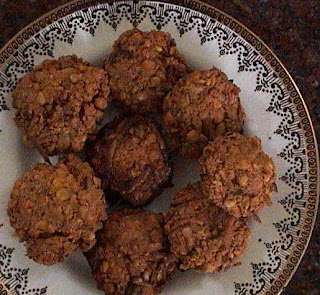Ama vadais and payasam are indispensable dishes in all festivals and feasts. Though there are varieties of vadai recipes. Ama vadai occupies the foremost position in a menu prepared for any festival. Ama vadai is prepared by frying a flattened ball of ground lentil and spice. Children and adults alike love to pop the vadais into their mouth, as and when they are fried. Many a time I have been left with no vadais to serve on the leaf at meal time. Old people love it when soaked in Rasam or Mor Kuzambu.
I have heard of a gigantic cousin of my grand father who used to consume a basketful of vadais at one sitting as he chatted with his friends. Just imagine the plight of the old aunt who had to grind the enormous quantities of the vadai dough in those ‘pre- electric mixer’ days.
INGREDIENTS:
Bengal gram dal - 2 cups
Red chillies - 4
Ginger – 2 inch piece
Asafoetida – 1 pinch
Curry leaves – a few
Fresh grated coconut- ¾ tea cup
Salt – 1 1/2 tsp
METHOD:
1. Soak Bengal gram dal with red chillies for half an hour.
2. Grind ginger, asafoetida and the soaked chillies with little of the soaked dal.
3. Now add the remaining soaked and drained dal and salt to the mixer and grind into a coarse mixture. Do not add water, as the mixture should be thick.
4. Mix in the grated coconut, and shredded curry leaves to the dough mix well. The vadai mixture is now ready.
5. Heat oil in a kadai.
6. Take a ¾ tablespoon of the vadai mixture and shape into a small ball, with your hand.
7. Keep the ball in the palm of one hand, and lightly press and flatten with three fingers of your other hand, giving the vadai the shape of a turtle’s back.
8. Drop it in hot oil and immediately decrease flame. Frying on a high flame, will cook the outer parts faster, and leave the insides uncooked.
9. When the vadai looks cooked, increase heat and continue to fry till it is golden red in colour.
10. Vadais can be cooked in batches of six or eight.
Enjoy them plain or savour it with mint or coconut chutney. While this is the traditional vadais prepared for festivals and as prasadam (offering for the Gods), one can add chopped onion, grated carrot, mint leaves and so on as per preferences.
While this is the traditional vadais prepared for festivals and as prasadam (offering for the Gods), one can add chopped onion, grated carrot, mint leaves and so on as per preferences.
I have heard of a gigantic cousin of my grand father who used to consume a basketful of vadais at one sitting as he chatted with his friends. Just imagine the plight of the old aunt who had to grind the enormous quantities of the vadai dough in those ‘pre- electric mixer’ days.
INGREDIENTS:
Bengal gram dal - 2 cups
Red chillies - 4
Ginger – 2 inch piece
Asafoetida – 1 pinch
Curry leaves – a few
Fresh grated coconut- ¾ tea cup
Salt – 1 1/2 tsp
METHOD:
1. Soak Bengal gram dal with red chillies for half an hour.
2. Grind ginger, asafoetida and the soaked chillies with little of the soaked dal.
3. Now add the remaining soaked and drained dal and salt to the mixer and grind into a coarse mixture. Do not add water, as the mixture should be thick.
4. Mix in the grated coconut, and shredded curry leaves to the dough mix well. The vadai mixture is now ready.
5. Heat oil in a kadai.
6. Take a ¾ tablespoon of the vadai mixture and shape into a small ball, with your hand.
7. Keep the ball in the palm of one hand, and lightly press and flatten with three fingers of your other hand, giving the vadai the shape of a turtle’s back.
8. Drop it in hot oil and immediately decrease flame. Frying on a high flame, will cook the outer parts faster, and leave the insides uncooked.
9. When the vadai looks cooked, increase heat and continue to fry till it is golden red in colour.
10. Vadais can be cooked in batches of six or eight.
Enjoy them plain or savour it with mint or coconut chutney.









